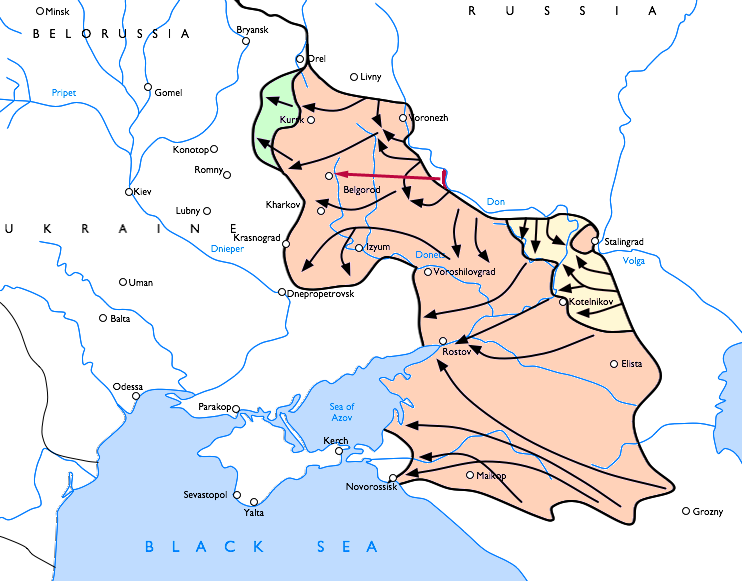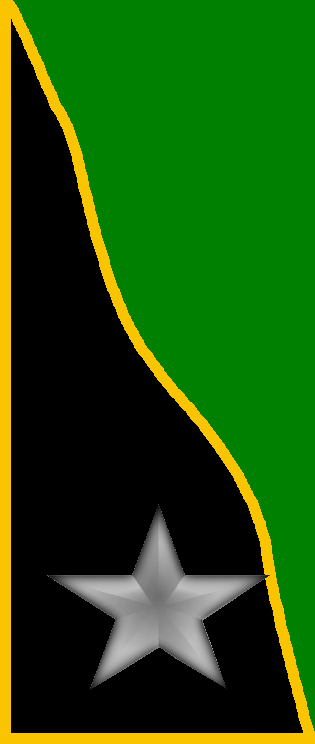|
Battle Of Nikolayevka
The Battle of Nikolayevka was the breakout of Italian forces in January 1943, as a small part of the larger Battle of Stalingrad. The breakout involved the Alpine Army Corps of the Italian 8th Army near the village of Nikolayevka (now Livenka, Belgorod Oblast, in Russia). Prelude On December 16, 1942, Soviet forces launched Operation Little Saturn aimed at the Italian 8th Army. The Soviet plan was to force the River Don, encircle and destroy the Italian 8th Army along the Don, then push towards Rostov-on-Don and thus cut off Army Group A fighting in the Caucasus. On December 16 General Vasily Kuznetsov's 1st Guards Army and General Dmitri Lelyushenko's 3rd Guards Army attacked the units of the Italian 8th Army, which were quickly destroyed—in three days the Red Army had opened a gap in the Axis front deep and wide and destroyed two of the Italian Army's Corps (2nd and 35th). The Soviet armored columns now rapidly advanced south towards the Black Sea. The breakout The I ... [...More Info...] [...Related Items...] OR: [Wikipedia] [Google] [Baidu] |
Battle Of Stalingrad
The Battle of Stalingrad (23 August 19422 February 1943) was a major battle on the Eastern Front of World War II where Nazi Germany and its allies unsuccessfully fought the Soviet Union for control of the city of Stalingrad (later renamed to Volgograd) in Southern Russia. The battle was marked by fierce close-quarters combat and direct assaults on civilians in air raids, with the battle epitomizing urban warfare. The Battle of Stalingrad was the deadliest battle to take place during the Second World War and is one of the bloodiest battles in the history of warfare, with an estimated 2 million total casualties. Today, the Battle of Stalingrad is universally regarded as the turning point in the European Theatre of war, as it forced the '' Oberkommando der Wehrmacht'' (German High Command) to withdraw considerable military forces from other areas in occupied Europe to replace German losses on the Eastern Front, ending with the rout of the six field armies of Army G ... [...More Info...] [...Related Items...] OR: [Wikipedia] [Google] [Baidu] |
Army Group A
Army Group A (Heeresgruppe A) was the name of several German Army Groups during World War II. During the Battle of France, the army group named Army Group A was composed of 45½ divisions, including 7 armored panzer divisions. It was responsible for breaking through the heavily-forested Ardennes region. The operation, which was part of ''Fall Gelb'' (Case Yellow), was resoundingly successful for the Germans, as the army group outflanked the best troops of France and its allies, eventually leading to France's surrender. In 1942, Army Group South on the Eastern Front against the Soviet Union was split into Army Group A and Army Group B, and Army Group A was responsible for the invasion into the Caucasus. In 1945, months before the fall of Nazi Germany, Army Group A was renamed Army Group Centre. Western Front, 1940 During the German invasion of the Low Countries and France Army Group A was under the command of Generaloberst Gerd von Rundstedt and was responsible for the break-out ... [...More Info...] [...Related Items...] OR: [Wikipedia] [Google] [Baidu] |
Voronezh Front
The 1st Ukrainian Front (Russian: Пéрвый Украи́нский фронт), previously the Voronezh Front (Russian: Воронежский Фронт) was a major formation of the Soviet Army during World War II, being equivalent to a Western army group. Background During the first months of the war, officers from 16 regions of Ukraine conscripted about 2.5 million people from military enlistment offices. 1.3 million militiamen from the left-bank and southern regions of Ukraine fought against the enemy. In 1941, about 3.185 million citizens of the Ukrainian SSR were sent to the Soviet Red Army and Navy. Replenishing mostly the units of the Southern and Southwestern fronts, the Ukrainian people formed the basis of the 37th, 38th, and 40th armies; and the 13th and 17th rifle divisions. Due to the conscription of civilians, the proportion of Ukrainian citizens fighting in south-west Ukraine reached 50%. This significantly exceeded the percentage of Ukrainians from t ... [...More Info...] [...Related Items...] OR: [Wikipedia] [Google] [Baidu] |
Filipp Golikov
Filipp Ivanovich Golikov (russian: Фили́пп Ива́нович Го́ликов, links=no; July 30, 1900 – July 29, 1980) was a Soviet military commander. As chief of the GRU (Main Intelligence Directorate), he is best known for failing to take seriously the abundant intelligence about Nazi Germany's plans for an invasion of the Soviet Union in June 1941, either because he did not believe them or because Joseph Stalin did not want to hear them. He served in subsequent campaigns and was promoted to the rank of Marshal of the Soviet Union in 1961. Early career Golikov was born into a peasant family of Russian ethnicity in Borisova, in the Perm Governorate of the Russian Empire. His father served as a medical orderly with the garrison in Tobolsk. Father and son both joined the Russian Communist Party (b) in April 1918. A month later, Golikov enlisted in the Red Army as a volunteer. He was a political commissar through most of the Russian Civil War, and for 11 years afterwar ... [...More Info...] [...Related Items...] OR: [Wikipedia] [Google] [Baidu] |
156th Infantry Division "Vicenza"
The 156th Infantry Division "Vicenza" ( it, 151ª Divisione di fanteria "Vicenza") was an infantry division of the Royal Italian Army during World War II. The Vicenza was formed on 10 March 1942 and named for the city of Vicenza. The Vicenza was classified as an occupation infantry division, which meant that the division's artillery regiment consisted of two artillery groups instead of the three artillery groups of line infantry divisions and that the divisional mortar battalion was replaced by a divisional machine gun battalion. The division was sent to the Eastern front, as part of the Italian Army in Russia. The division guarded the army's line of communications and rear area against Soviet partisans. The Vicenza was overrun and destroyed by Soviet forces during Operation Little Saturn. Of the division's 10,466 men 7,760 were killed or missing during the battle in January 1943. History World War I The division's lineage begins with the Brigade "Vicenza" raised in July 1917 ... [...More Info...] [...Related Items...] OR: [Wikipedia] [Google] [Baidu] |
4th Alpine Division "Cuneense"
The 4th Alpine Division "Cuneense" ( it, 4ª Divisione alpina "Cuneense") was a division of the Royal Italian Army during World War II, which specialized in mountain warfare. The headquarters of the division was in the city of Cuneo, and the majority of its Alpini soldiers were drafted from the surrounding Province of Cuneo - hence the division's name "Cuneense". The division participated in all Italian World War II campaigns with the exception of the North African Campaign. The division was annihilated during Operation Little Saturn by Soviet forces in January 1943. History The division's lineage begins on 19 October 1933 when the 1st Alpini Regiment in Mondovì and 2nd Alpini Regiment in Cuneo left the 1st Alpine Division "Taurinense" and entered the newly raised IV Alpine Brigade in Cuneo. On 27 October 1934 the brigade changed its name to IV Superior Alpine Command, which received the name Cuneense in December of the same year ( it, IV Comando Superiore Alpino "Cuneense"). ... [...More Info...] [...Related Items...] OR: [Wikipedia] [Google] [Baidu] |
3rd Alpine Division "Julia"
The 3rd Alpine Division "Julia" ( it, 3ª Divisione alpina "Julia") was a division of the Royal Italian Army during World War II, which specialized in mountain warfare. The Alpini that formed the divisions are a highly decorated, elite mountain corps of the Italian Army comprising both infantry and artillery units. Today the traditions and name of the 3rd Alpine Division "Julia" are carried on by the Alpine Brigade "Julia". History The division's lineage begins with the III Alpine Brigade formed in Udine on 11 March 1926 with the 8th Alpini Regiment in Udine and 9th Alpini Regiment in Gorizia and the 3rd Mountain Artillery Regiment in Belluno. On 27 October 1934 the brigade changed its name to 3rd Superior Alpine Command, which received the name Julio in December of the same year ( it, 2° Comando Superiore Alpino "Julio"). On 10 September 1935 the III Superior Alpine Command "Julio" was reformed as 3rd Alpine Division "Julia" with the 7th, 8th, and 9th Alpini regiments and t ... [...More Info...] [...Related Items...] OR: [Wikipedia] [Google] [Baidu] |
2nd Alpine Division "Tridentina"
The 2nd Alpine Division "Tridentina" ( it, 2ª Divisione alpina "Tridentina") was a division of the Royal Italian Army during World War II, which specialized in mountain warfare. The Alpini that formed the divisions are a highly decorated and elite mountain corps of the Italian Army comprising both infantry and artillery units. The name Tridentina was chosen as the division was based in the Trentino-South Tyrol region, for which the fascist regime of Benito Mussolini had created the neologism Venezia Tridentina. After World War II, the traditions and name of the 2nd Alpine Division "Tridentina" were carried on by the Alpine Brigade "Tridentina". History The division's lineage begins with the II Alpine Brigade formed on 11 March 1926 in Verona with the 5th Alpini Regiment in Milan, 6th Alpini Regiment in Brixen, and 7th Alpini Regiment in Belluno and the 2nd Mountain Artillery Regiment (Italy), 2nd Mountain Artillery Regiment in Bergamo. On 27 October 1934 the brigade changed i ... [...More Info...] [...Related Items...] OR: [Wikipedia] [Google] [Baidu] |






